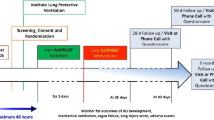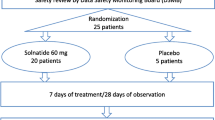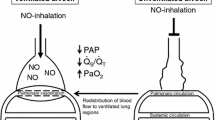Abstract
Acute lung injury (ALI) and the more severe acute respiratory distress syndrome (ARDS) are forms of pulmonary edema that result from robust local and systemic inflammatory states, such as sepsis. The morbidity and mortality associated with ALI and ARDS are significant and the treatment of these conditions presents a formidable challenge. Controlling hyperglycemia with insulin is a core component of patient management in the critically ill. Insulin treatment also exerts beneficial metabolic effects beyond glucose control, as well as non-metabolic effects, in insulin-resistant states. For instance, insulin inhibits NF-κB—dependent synthesis of pro-inflammatory factors and attenuates production of ROS. Indeed, intravenous administration of insulin ameliorates pulmonary injury and dysfunction in the LPS model of ALI. Most recently, an inhalable insulin formulation was shown to effectively reduce glucose concentrations with minimal impact on long-term pulmonary function. We propose that administering inhalable insulin to hyperglycemic ALI/ARDS patients could directly reduce alveolar inflammation while reducing circulating glucose levels.
Similar content being viewed by others
Notes
The ratio of the partial pressure of oxygen in arterial blood (PaO2) to the inspired oxygen fraction (FiO2) PaO2/FIO2 is a clinical measurement of oxygenation status and reflects overall function of the capillary-alveolar unit and matching of blood flow to ventilation.
References
Leaver, S.K., and T.W. Evans. 2007. Acute respiratory distress syndrome. BMJ 335(7616): 389–394.
Bernard, G.R., A. Artigas, K.L. Brigham, J. Carlet, K. Falke, L. Hudson, et al. 1994. The American-European consensus conference on ARDS. Definitions, mechanisms, relevant outcomes, and clinical trial coordination. American Journal of Respiratory and Critical Care Medicine 149: 818–824.
Piantadosi, C.A., and D.A. Schwartz. 2004. The acute respiratory distress syndrome. Annals of Internal Medicine 141(6): 460–470.
Wheeler, A.P., and G.R. Bernard. 2007. Acute lung injury and the acute respiratory distress syndrome: a clinical review. Lancet 369(9572): 1553–1564.
Dungan, K.M., S.S. Braithwaite, and J.C. Preiser. 2009. Stress hyperglycaemia. Lancet 373(9677): 1798–1807.
Fahy, B.G., A.M. Sheehy, and D.B. Coursin. 2009. Glucose control in the intensive care unit. Critical Care Medicine 37(5): 1769–1776.
Hayashi, T., T. Hirano, T. Yamamoto, Y. Ito, and M. Adachi. 2006. Intensive insulin therapy reduces small dense low-density lipoprotein particles in patients with type 2 diabetes mellitus: relationship to triglyceride-rich lipoprotein subspecies. Metabolism 55(7): 879–884.
Mesotten, D., J.V. Swinnen, F. Vanderhoydonc, P.J. Wouters, and G. Van den Berghe. 2004. Contribution of circulating lipids to the improved outcome of critical illness by glycemic control with intensive insulin therapy. Journal of Clinical Endocrinology and Metabolism 89(1): 219–226.
Wendel, M., R. Paul, and A.R. Heller. 2007. Lipoproteins in inflammation and sepsis. II. Clinical aspects. Intensive Care Medicine 33(1): 25–35.
Muniyappa, R., M. Iantorno, and M.J. Quon. 2008. An integrated view of insulin resistance and endothelial dysfunction. Endocrinology and Metabolism Clinics of North America 37(3): 685–711.
Dandona, P., P. Mohanty, A. Chaudhuri, R. Garg, and A. Aljada. 2005. Insulin infusion in acute illness. Journal of Clinical Investigation 115(8): 2069–2072.
Langouche, L., I. Vanhorebeek, D. Vlasselaers, S. Vander Perre, P.J. Wouters, K. Skogstrand, T.K. Hansen, and G. Van den Berghe. 2005. Intensive insulin therapy protects the endothelium of critically ill patients. Journal of Clinical Investigation 115(8): 2277–2286.
Dandona, P., A. Aljada, P. Mohanty, H. Ghanim, W. Hamouda, E. Assian, and S. Ahmad. 2001. Insulin inhibits intranuclear nuclear factor kappaB and stimulates IkappaB in mononuclear cells in obese subjects: evidence for an anti-inflammatory effect? Journal of Clinical Endocrinology and Metabolism 86(7): 3257–3265.
Aljada, A., H. Ghanim, P. Mohanty, N. Kapur, and P. Dandona. 2002. Insulin inhibits the pro-inflammatory transcription factor early growth response gene-1 (Egr)-1 expression in mononuclear cells (MNC) and reduces plasma tissue factor (TF) and plasminogen activator inhibitor-1 (PAI-1) concentrations. Journal of Clinical Endocrinology and Metabolism 87: 1419–1422.
Dandona, P., A. Chaudhuri, P. Mohanty, and H. Ghanim. 2007. Anti-inflammatory effects of insulin. Current Opinion in Clinical Nutrition and Metabolic Care 10(4): 511–517.
Aljada, A., H. Ghanim, R. Saadeh, and P. Dandona. 2001. Insulin inhibits NFkappaB and MCP-1 expression in human aortic endothelial cells. Journal of Clinical Endocrinology and Metabolism 86(1): 450–453.
Aljada, A., P. Mohanty, H. Ghanim, T. Abdo, D. Tripathy, A. Chaudhuri, and P. Dandona. 2004. Increase in intranuclear nuclear factor kappaB and decrease in inhibitor kappaB in mononuclear cells after a mixed meal: evidence for a proinflammatory effect. American Journal of Clinical Nutrition 79(4): 682–690.
Evans, J.L., I.D. Goldfine, B.A. Maddux, and G.M. Grodsky. 2003. Are oxidative stress-activated signaling pathways mediators of insulin resistance and beta-cell dysfunction? Diabetes 52(1): 1–8.
Dugo, L., M. Collin, D.A. Allen, O. Murch, S.J. Foster, M.M. Yaqoob, and C. Thiemermann. 2006. Insulin reduces the multiple organ injury and dysfunction caused by coadministration of lipopolysaccharide and peptidoglycan independently of blood glucose: role of glycogen synthase kinase-3beta inhibition. Critical Care Medicine 34(5): 1489–1496.
Jeschke, M.G., H. Rensing, D. Klein, T. Schubert, A.E. Mautes, U. Bolder, and R.S. Croner. 2005. Insulin prevents liver damage and preserves liver function in lipopolysaccharide-induced endotoxemic rats. Journal of Hepatology 42(6): 870–879.
Kidd, L.B., G.A. Schabbauer, J.P. Luyendyk, T.D. Holscher, R.E. Tilley, M. Tencati, and N. Mackman. 2008. Insulin activation of the phosphatidylinositol 3-kinase/protein kinase B (Akt) pathway reduces lipopolysaccharide-induced inflammation in mice. Journal of Pharmacology and Experimental Therapeutics 326(1): 348–353.
Hagiwara, S., H. Iwasaka, A. Hasegawa, H. Koga, and T. Noguchi. 2008. Effects of hyperglycemia and insulin therapy on high mobility group box 1 in endotoxin-induced acute lung injury in a rat model. Critical Care Medicine 36(8): 2407–2413.
Guntur, V.P., and R. Dhand. 2007. Inhaled insulin: extending the horizons of inhalation therapy. Respiratory Care 52(7): 911–922.
Kling, J. 2008. Inhaled insulin’s last gasp? Nature Biotechnology 26(5): 479–480.
Mitri, J., and A.G. Pittas. 2009. Inhaled insulin–what went wrong. Nat Clin Pract Endocrinol Metab 5(1): 24–25.
Rave, K., T. Heise, A. Pfützner, and A.H. Boss. 2008. Coverage of postprandial blood glucose excursions with inhaled technosphere insulin in comparison to subcutaneously injected regular human insulin in subjects with type 2 diabetes. Diabetes Care 30(9): 2307–2308.
Rosenstock, J., R. Bergenstal, R.A. Defronzo, I.B. Hirsch, D. Klonoff, A.H. Boss, D. Kramer, R. Petrucci, W. Yu, B. Levy, and 0008 Study Group. 2008. Efficacy and safety of Technosphere inhaled insulin compared with Technosphere powder placebo in insulin-naive type 2 diabetes suboptimally controlled with oral agents. Diabetes Care 31(11): 2177–2182.
Bergenstal et al. Comparative Efficacy and Safety of AFRESA™ and a Rapid-Acting Analog Both Given with Glargine in Subjects with T1DM in a 52-Week Study. Abstract # 479-P, ADA conference 2009. http://ww2.aievolution.com/ada0901/index.cfm?do = abs.viewAbs&abs = 6624 accessed October 2009.
ADA 2009: New Inhaled Insulin Has Rapid Onset of Action With No Adverse Effect on Lung Function. Medscape Medical News. http://www.medscape.com/viewarticle/704092. accessed October 2009.
HOW DOES THE TECHNOSPHERE® INSULIN SYSTEM WORK? http://www.mannkindcorp.com/technosphere_insulin.aspx. accessed July 13 2009.
Gonzalez, P.K., J. Zhuang, S.R. Doctrow, B. Malfroy, P.F. Benson, M.J. Menconi, and M.P. Fink. 1996. Role of oxidant stress in the adult respiratory distress syndrome: evaluation of a novel antioxidant strategy in a porcine model of endotoxin-induced acute lung injury. Shock 6(Suppl 1): S23–S26.
Martins, J.O., F.L. Zanoni, D.O. Martins, R. Coimbra, J.E. Krieger, S. Jancar, and P. Sannomiya. 2009. Insulin regulates cytokines and intercellular adhesion molecule-1 gene expression through nuclear factor-kappaB activation in LPS-induced acute lung injury in rats. Shock 31(4): 404–409.
de Oliveira, M.J., A.R. Meyer-Pflug, T.C. Alba-Loureiro, H. Melbostad, J.W. Costa da Cruz, R. Coimbra, R. Curi, and P. Sannomiya. 2006. Modulation of lipopolysaccharide-induced acute lung inflammation: role of insulin. Shock 25(3): 260–266.
Chen, H.I., D.Y. Yeh, H.L. Liou, and S.J. Kao. 2006. Insulin attenuates endotoxin-induced acute lung injury in conscious rats. Critical Care Medicine 34(3): 758–764.
Alba-Loureiro, T.C., E.F. Martins, R.G. Landgraf, S. Jancar, R. Curi, and P. Sannomiya. 2006. Role of insulin on PGE2 generation during LPS-induced lung inflammation in rats. Life Sciences 78(6): 578–585.
Donnelly, M., C. Condron, P. Murray, and D. Bouchier-Hayes. 2007. Modulation of the glycemic response using insulin attenuates the pulmonary response in an animal trauma model. Journal of Trauma 63(2): 351–357.
Martins, J.O., M. Ferracini, N. Ravanelli, R.G. Landgraf, and S. Jancar. 2008. Insulin suppresses LPS-induced iNOS and COX-2 expression and NF-kappaB activation in alveolar macrophages. Cellular Physiology and Biochemistry 22(1–4): 279–286.
Honiden, S., and M. N. Gong. 2009. Diabetes, insulin, and development of acute lung injury. Critical Care Medicine, Jun 15. [Epub ahead of print.
Krein, P.M., P.J. Sabatini, W. Tinmouth, F.H. Green, and B.W. Winston. 2003. American Journal of Respiratory and Critical Care Medicine 167(1): 83–90.
Author information
Authors and Affiliations
Corresponding author
Rights and permissions
About this article
Cite this article
Shapiro, H., Kagan, I., Shalita-Chesner, M. et al. Inhaled Aerosolized Insulin: A “Topical” Anti-inflammatory Treatment for Acute Lung Injury and Respiratory Distress Syndrome?. Inflammation 33, 315–319 (2010). https://doi.org/10.1007/s10753-010-9187-2
Published:
Issue Date:
DOI: https://doi.org/10.1007/s10753-010-9187-2




